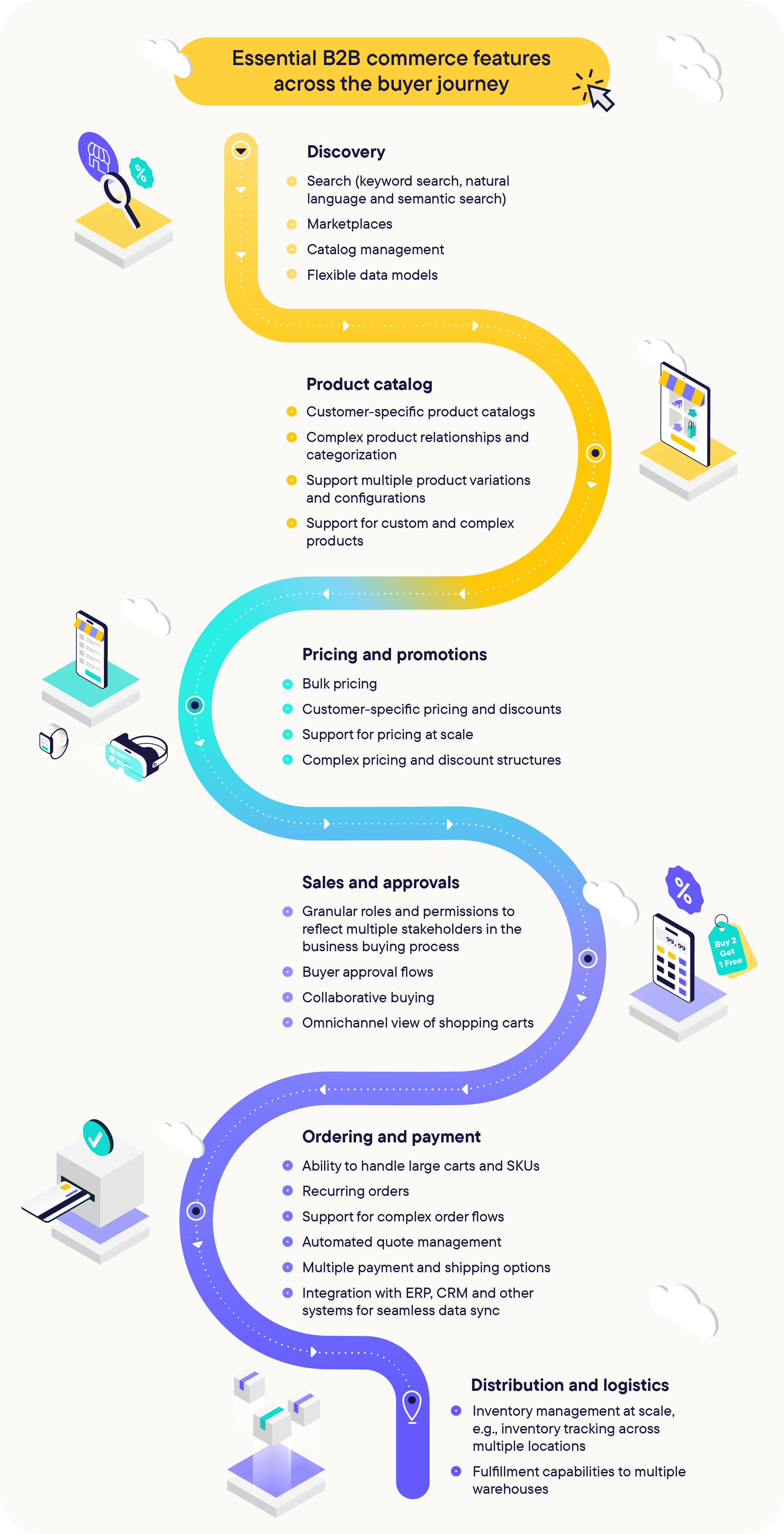
What you’ll learn:

Introduction
As 52% of business and financial leaders in B2B organizations revealed that their commerce technology stack will reach its end of life within the next two years, it’s clear that the B2B eCommerce market will continue to evolve in the face of ever-growing customer expectations, from omnichannel to personalized journeys.
So, how can B2B players achieve the digital maturity needed to create frictionless experiences that capture market share faster? And how can they scale for their enterprise needs?
The unlimited flexibility and agility of composable commerce enable B2B businesses to respond to changing buyer expectations AND achieve digital maturity faster. commercetools B2B Commerce has enabled hundreds of manufacturers, wholesalers and distributors to become digital outperformers, grow their revenue, optimize their efficiency and get to market faster — all the while delivering superior digital commerce experiences for all types of customers.
If you’re considering going composable, it’s important to sift through the noise when evaluating vendors. We compiled the vital factors to consider and questions to ask both of your vendors and within your organization about strategy, functionality, costs, timing and implementation, so you’re ready to select the right enterprise platform to future-proof your commerce.
💡Leverage the commercetools RFP Builder for your vendor selection process.
1. Vision and strategy
A vendor’s long-term vision and near-term product roadmap are crucial elements to consider, as is the amount of focus the vendor dedicates to a B2B-specific offering, from strategy and existing features to staff and expertise.
Dig deeper to learn about the current situation and strategy behind the vendor’s partner ecosystem. Also, consider whether implementation partners are qualified to deliver composable implementations.
Questions you should ask:
2. Underlying composable commerce infrastructure
Get to know if the infrastructure under the hood of potential vendors is aligned with composable principles, including:
Component-based: Identify if the vendor’s architecture provides modular and interchangeable components (“best-of-breed”), so your business can add or swap components anytime and without vendor lock-in.
Cloud-native SaaS: By leveraging the scalability and resilience of cloud computing with providers such as Google Cloud and Amazon Web Services (AWS), B2B organizations can unlock elastic cloud access for automatic scaling to manage online capacity and ensure performance.
Technology-agnostic: An authentic composable architecture doesn’t require specific programming languages and certifications, and isn’t tied to proprietary infrastructure. Your engineering team has the freedom to code, monitor and manage applications according to your company’s needs.
Multi-tenant and versionless architecture: Ensure you’re not going to be trapped on old versions that require forced updates and upgrades.
Security: Ensure potential vendors comply with key regulations and handle customer data responsibly. Holistically evaluate the security ecosystem, including compliance, performance management, physical, network and platform security.
Questions you should ask:
3. Costs and timing
Evaluate the elements of total costs of ownership (TCO) of the vendor, like the pricing model and the average implementation cost, by the project size and projected costs over a 5-year window.
Metrics such as the typical time to go live and the average setup and integration costs (when implemented directly or via an implementation partner) will give you vital information to evaluate whether the potential vendor is within your budget and can fulfill your timeline requirements.
Questions you should ask:
4. Enterprise-grade capabilities, features and scale
It’s time to get down to the specifics. The first step is to dig deeper into high-level capabilities — such as the ability to support multiple business models (B2B, B2C, D2C, B2B2C) on a single commerce platform, how your company can model and activate customer and product data, and how flexible, robust and configurable the product modeling capabilities are. The goal is to assess the vendor’s extensibility and how well it aligns with your unique business needs. If you want to do something unique, ensure your vendor can support that differentiation early on.
Just as important is evaluating enterprise-grade scale — the platform’s ability to support thousands (or millions) of SKUs, process high-volume transactions across multiple regions and ensure performance under peak loads. This includes cloud-native infrastructure, global data compliance and advanced localization features. Scalability isn’t just about handling growth; it’s about maintaining agility and speed while expanding to new markets, channels or business models without major rewrites or downtime.
Another dimension you should consider is the ability to support omnichannel commerce and hybrid sales. According to Gartner, 92% of B2B buyers prefer digital sales interactions, with 75% preferring an experience without a sales representative — proving that eCommerce isn’t an all-or-nothing proposition.
The next part of this “capability audit” is understanding the out-of-the-box product features — especially for complex B2B use cases. These include support for advanced product catalogs, large carts, recurring orders, customer-specific product catalogs, pricing and promotions, etc. Here’s an overview of the native features to consider throughout the buyer journey:

Questions you should ask:
Enterprise-grade scale
High-level capabilities
Out-of-the-box features
Omnichannel and hybrid sales
5. Integrations
A commerce vendor might not have all the functionalities out of the box, but it should provide the means to seamlessly unlock those features from best-of-breed solutions. The ability to integrate, activate and extend the system’s capabilities is essential to supporting B2B firms in unlocking the full potential of eCommerce — and that’s where the API-first approach shines through.
From the B2B perspective, the ERP system is a critical integration. You can extend an API to your backend ERP integration without affecting the rest of your infrastructure, enabling a seamless sync with the commerce system. The same can be said about other systems of record, such as CPQ, OMS and CRM.
Consider whether the vendor can provide a proper best-of-breed strategy, free of vendor lock-in, that enables your business to integrate services that best meet its requirements. Lastly, evaluate how comprehensive and easily accessible the API documentation is and how easily business users (e.g., marketers, content managers, etc.) can manage integrations in a no-code/low-code interface.
Questions you should ask:
6. Implementation models
To complete your evaluation, check what kinds of implementation models are available. Consider how your company can embrace the composable approach with an incremental approach, such as the strangler pattern. The ability to create prototypes, minimum viable products (MVPs) and proofs-of-concept (POCs) helps many companies adopt composable commerce to try out components and experiment freely — and without disrupting their existing infrastructure.
Choosing the right implementation partner is also vital for many B2B enterprises going composable, and you should dive deeper into the partner ecosystem of potential vendors. Get to know the strategy (as mentioned earlier) and the existing partners available for implementation in your region and whether they are B2B-focused. Double-check the track record of partners experienced in composable implementations and their use of best practices to speed up time to market, such as accelerators and pre-built integrations.
Questions you should ask:
Choosing an enterprise B2B eCommerce platform made easy
You don’t have to spend months evaluating your future B2B eCommerce vendor. These questions help create a shortlist of potential vendors, and you can also refer to independent research by leading analysts, such as the B2B Paradigm Combine, to get in-depth clarity on vendors’ capabilities that best match your business needs.
To find out more about relevant criteria for B2B organizations and what vendors are better equipped to fulfill those needs, download the 2025 Paradigm B2B Combine Digital Solutions for B2B for Enterprise — and learn how commercetools Composable Commerce for B2B performed in each category.